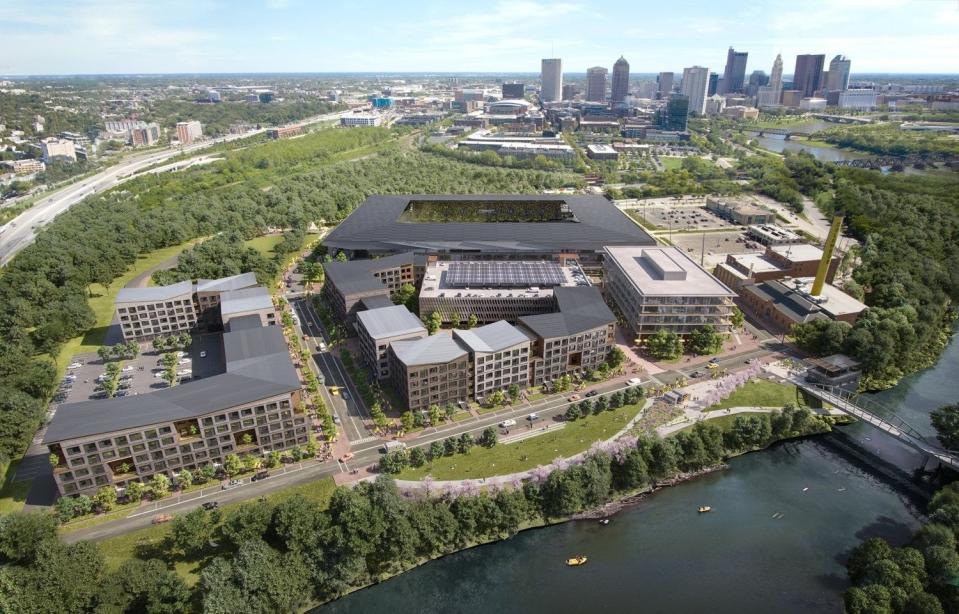Advocates want money for brownfield cleanup, demolition restored to DeWine budget

- Oops!Something went wrong.Please try again later.
Gov. Mike DeWine's proposed budget does not specifically include money for brownfield cleanup or demolition of decaying properties in Ohio, but a spokesman said the administration is willing to discuss them as the budgeting process continues.
Advocates of the programs said they are necessary to clear the way for needed development that otherwise wouldn't be done.
"We're certainly willing to have the conversation," DeWine spokesman Dan Tierney said.
The two-year budget does not include specific funding for the Brownfield Remediation Program or the Building Demolition and Site Revitalization Program.
But Tierney said money for brownfield cleanup and demolitions could be included in the $2.5 billion All Ohio Future Fund that DeWine touted in his Jan. 31 State of the State address laying out the budget.
DeWine said that the money would be used to "prepare the infrastructure of large economic development sites." Then employers could move immediately on to a clean site, said Sarah Wickham, Ohio Department of Development spokeswoman.
According to the nonprofit Greater Ohio Policy Center, the Brownfield Remediation Fund and the Building Demolition and Site Revitalization Program invested nearly $500 million throughout the state to deal with blight since they were created in 2021: $350 million for brownfields and $150 million for demolitions.
Alison Goebel, Greater Ohio's executive director, said she was disappointed that the programs are not directly funded in the budget because they have had a good impact in Ohio.
"Everyone that we have talked to at the Statehouse has said that this is a good program," Goebel said. "These were wildly popular programs with clear benefits."
Recently, for example, the state awarded Franklin County about $13 million to demolish the long-vacant Westland Mall, described as an eyesore on the West Broad Street gateway to the city.
"I know that there is a need out here. I know the state understands that as well," said Curtiss Williams, president and CEO of the Central Ohio Community Improvement Corporation — Franklin County's land bank — which applied for the Westland Mall money on the county's behalf.
A Greater Ohio Policy Center website said state brownfield money has gone to several projects in the Columbus area, including $1.52 million for the Pizzuti Companies' mixed-use Astor Park development of apartments and commercial space near the Columbus Crew's Lower.com Field, and $3.1 million toward the redevelopment of the old Kroger bakery on Cleveland Avenue near Downtown for apartments, offices, restaurant and retail space.

Those are the types of projects that benefit from the funding, said Mark Lundine, Columbus' economic development administrator, who wants to see the state continue the programs.
"Get the contamination cleaned up. Only after that can we talk about developing the property," Lundine said.
Jim Schimmer, Franklin County's director of economic development and planning, said state money has proven to be of tremendous benefit in Franklin County over the years.
"The key thing is there's not a better poster child than Columbus," Schimmer said, citing grants from the state's former Clean Ohio program that helped pay to clean up the old Gowdy Field site near Route 315 and Grandview Heights, which is now home to Spectrum and the Ohio State University's Eye & Ear Institute and the Stefanie Spielman Comprehensive Breast Center.
"I really believe that none of those projects would have started without money from the state," Schimmer said. "Brownfields by their nature are incredibly expensive and difficult to understand. That’s been the advantage we’ve seen in central Ohio for sure."
David Mann, president and CEO of the Lucas County Land Bank in northwest Ohio, said the state program provided $1.39 million for two downtown Toledo office buildings — the 17-story Nicholas Building and 11-story Spitzer Building — for asbestos, lead paint and hazardous materials removal. Developers want to convert the office buildings to residential and commercial space, Mann said.
"Brownfield money is not the kind of money the private sector makes investments toward," Mann said.
mferench@dispatch.com
@MarkFerenchik
This article originally appeared on The Columbus Dispatch: DeWine needs to fund brownfields cleanup, demolition, officials say

